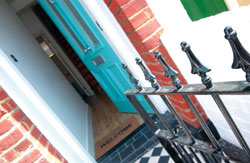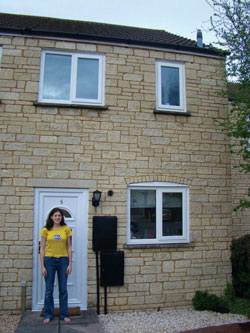 The property ladder can be difficult for first-time buyers. But once you’re on, it’s much easier to move on up. Our guide tells you everything you need to know about taking that crucial first step
The property ladder can be difficult for first-time buyers. But once you’re on, it’s much easier to move on up. Our guide tells you everything you need to know about taking that crucial first step
Buying your first house is the biggest investment you’re likely to make in your life – so it’s vital to get it right. When you buy a house you’re essentially taking on 25 years of debt – not something to be entered into without careful consideration.
There are a huge number of factors to consider when buying your first property, from choosing a mortgage that’s right for you down to the minutiae of whether you want to tackle any DIY once you’ve moved in. Making the right choice is all about knowing what you want – both now and in the future.
What do you want and need?
Before you spend time trawling round various properties, draw up a list of exactly what you want from your first home.
Think about the number of bedrooms you’ll need or can manage with; the amount of living and outdoor space you’d like.
Other key factors to consider include the cost of your commute to work. How much is the council tax going to cost? Has the house has been on the market for a long time? If so, why? And be cautious…
Is the house near a busy road or a railway line? Will the noise annoy you? Is the property near a rowdy pub? How near to schools is it? While having good local schools nearby can be a good thing in terms of re-sale, sometimes a house can be too close to a school, in terms of the traffic chaos at the start and end of the school day.
You also need to make sure you and your partner agree on the type of house you want – or if you don’t agree, at least that you’re both prepared to compromise! Do you want a new build or a period property? Do you want a terraced,a semi-detached or a detached house? If you’re a sun-worshipper, does your garden have to be south facing? Do you want a wreck of a property that you can rip out and start again or a brand new house that doesn’t even need a lick of paint?
Look to the future, too. Does the house you’re interested in have the potential for expansion? If you find your dream home in a conservation area, you may find it difficult to get planning permission for an extension. And while you might not be thinking about starting a family now, you may later on – will you have enough space for kids, and what are the schools like in the area?
Some house building companies, such as Haslam Homes, specialise in providing affordable, but extremely desirable, new homes predominantly for first- or second-time buyers. These companies can help to make your buying experience as efficient and stress-free as possible.
Do the maths
Before y ou start looking for your new home, it’s vital to do your sums. Work out exactly how much you can afford and how much you can borrow. Remember to factor in the cost of buying – solicitor’s fees, surveys and stamp duty can all add thousands. Aim to have a deposit of at least 10% of the value of the property you want to buy. This will help you to secure a much lower mortgage rate.
ou start looking for your new home, it’s vital to do your sums. Work out exactly how much you can afford and how much you can borrow. Remember to factor in the cost of buying – solicitor’s fees, surveys and stamp duty can all add thousands. Aim to have a deposit of at least 10% of the value of the property you want to buy. This will help you to secure a much lower mortgage rate.
When you do start looking, don’t lose sight of what you can afford. It’s easy to fall in love with something that’s just that few thousand more than you budgeted for. But don’t be tempted. There’s no point looking at properties in the £300,000 bracket if your spending power is only £250,000. Buying your first house has enormous emotional and aspirational dreams attached to it, but don’t let these cloud your ability to make a sensible decision. You don’t want to end up having to push yourself so hard to meet your mortgage repayments that you become stressed to the point of not even enjoying your new home.
Know your area
Always research the area you’re interested in. If you’re not already familiar with it, visit it at different times of the day and night, as well as at weekends and during the week. You may find that up-and-coming areas are next to places that are already popular. If you’re prepared to compromise a little on where you live, you may be able to get a bigger house for your money. Many buyers are prepared to do this, and ultimately this starts a ripple effect, turning an area that was previously not so popular into one that becomes the place to live in a few years’ time.
Find out if the area you’re interested in is going to undergo any government spending in the near future. If so, such areas are a great place to buy, because as the area is improved, in terms of travel, retail and housing, it becomes an attractive place to live and demand – and prices – will rise.
Good indications that a mini-boom is on the way are increases in the number of consumer-led businesses, such as gift shops, or trendy bars and smart cafes. If you notice skips and scaffolding outside houses, it’s also a sign that an area is on the up.
Be proactive
Despite estate agents wanting to make sales, you still need to be keen. Make sure you give them all your contact details and get yourself on several mailing lists. Always keep on top of properties that are coming on to the market in your area. Search the internet, too – but be as specific as possible when you search.
All the little extras
When you finally come to move into your new home, you’re not going to want to live in an empty shell. So don’t forget to budget for the cost of furniture and fittings. You may be lucky enough to have some already, but if your new home is your first house, as opposed to a studio or flat, you’ll have more rooms to furnish. Some sellers are happy to include some or all of the white goods in the cost of the house, so that may help. But otherwise if you can’t afford to buy new, think about bidding on ebay or use the recycling website, http://uk.freecycle.org
Five essential questions to ask your vendor
- When are they planning to move?
- How long have they lived there?
- What is the locality and the area like?
- Do all the improvements they’ve made have warranties, permissions, and were they done professionally?
- Why do they want to sell?
Mortgage basics There are two basic types of mortgage: repayment (also called capital and interest) and interest-only
Repayment
Monthly repayments include a proportion of the sum borrowed (the capital) as well as the interest. Provided you keep up the payments, by the end of the mortgage term, the property will be all yours. This option is safer and, in the long-run, cheaper than an interest-only mortgage.
Interest-only
 Monthly repayments cover the interest charged on the sum borrowed. Monthly costs are lower than a repayment mortgage, but you’re not paying off the capital so you’ll still owe the original amount at the end of the mortgage term. If you can’t repay it, your house can be repossessed.
Monthly repayments cover the interest charged on the sum borrowed. Monthly costs are lower than a repayment mortgage, but you’re not paying off the capital so you’ll still owe the original amount at the end of the mortgage term. If you can’t repay it, your house can be repossessed.
‘Location, price and two bedrooms were vital factors in our choice’
Deborah Fosbrook, 22, a credit analyst, and James Hiscott, 23, a technical support manager, bought their first home together in Bicester, Oxfordshire, last March
‘We’d been travelling for a year and we knew when we got back we wanted to live together. Initially, we didn’t know where. But then James got a job in Bicester, so we decided to rent in the area to see if we liked it.
‘We rented in an area called Langford and really liked it, so decided to buy there. Location was very important to us – it’s only a 15-minute walk into the centre of Bicester, has good bus routes for James to get to work, and it’s near the main road to Milton Keynes where I work, so it was ideal. It also has lots of green space, which was important to us.
‘Price was vital factor, too. We had an absolute upper limit of £210,000. But, ideally, we wanted to stick to £185,000 and under. We liked the idea of two bedrooms, and we didn’t want the second room to be a box room. Luckily, we agreed on the type of house we preferred – something fairly new that didn’t need much work. We looked at about seven properties in total before putting the offer in on the one we got.
‘We have a two-year tracker mortgage with Nationwide. Before settling on it, we got advice from a mortgage adviser. We were lucky because we both had savings. We were able to pay a deposit of £18,000 and we got the house for £180,000. Originally, it had been on for £190,000.
‘Our house is quite near a busy road but we’re not at home during the busy times so it’s not an issue for us. And as we have double glazing we don’t hear it either. Double glazing was something we looked for in the properties we saw as we knew it would help with lowering energy costs.
‘And although I wasn’t really thinking about schools, the local primary school is the best in the area, so it was an added bonus as we plan to stay in Bicester for some time.
‘The whole process was fairly straightforward – it took about three months in total. The hardest bit was moving day itself as we only had a small car!
‘All our white goods were included in the purchase price, and we had just enough furniture to live with – a bed, a wardrobe and a sofa. The sofa came from freecycle. We’ve been in our new house a month now and we’ve just bought a new sofa!
‘We bought at the right time because mortgage deals were good and house prices were going down.’
Home Information Packs (HIPs) – what are they?
Since December 2007, every house put up for sale must have a Home Information Pack (HIP). Put together by the seller, this pack brings together vital information at the start of the sale process. It must contain:
- A sale statement summarising the terms of sale.
- Local searches. This may include planning decisions and road building proposals, as well as the provision of drainage and water services to the property.
- Evidence of title. This proves that the seller owns the property and has the right to sell it.
- An Energy Performance Certificate that contains advice on how to cut carbon dioxide emissions and fuel bills.
- Leasehold or commonhold documents, where appropriate.
- An index of contents. The index should explain the reason why any of the required documents are missing.
The pack can also include other information that would be of interest to buyers such as a home condition report, other searches and any guarantees and warranties on the property. It might also contain a legal summary and answers to standard enquiries made of the sellers.
Regulations of HIPs prohibit the inclusion of marketing or advertising material in the Pack, so it should only include the official material.
How do I get a HIP?
Just ask the estate agent who is selling the house you’re interested in. It must give you a copy free of charge (athough you may be charged a reasonable sum for the cost of copying and posting it to you). If the seller isn’t using an estate agent, you must ask to get the Pack directly from them. You have a right to see the HIP for any property that you are interested in – and by looking at the HIP you could save yourself time and money in the long-run.
Written By Rasmi Madan
PHOTOGRAPHS: NICKY JOHNSTON, lewisimagebank.com
First Published in At Home with Andrew Winter, June 2008


